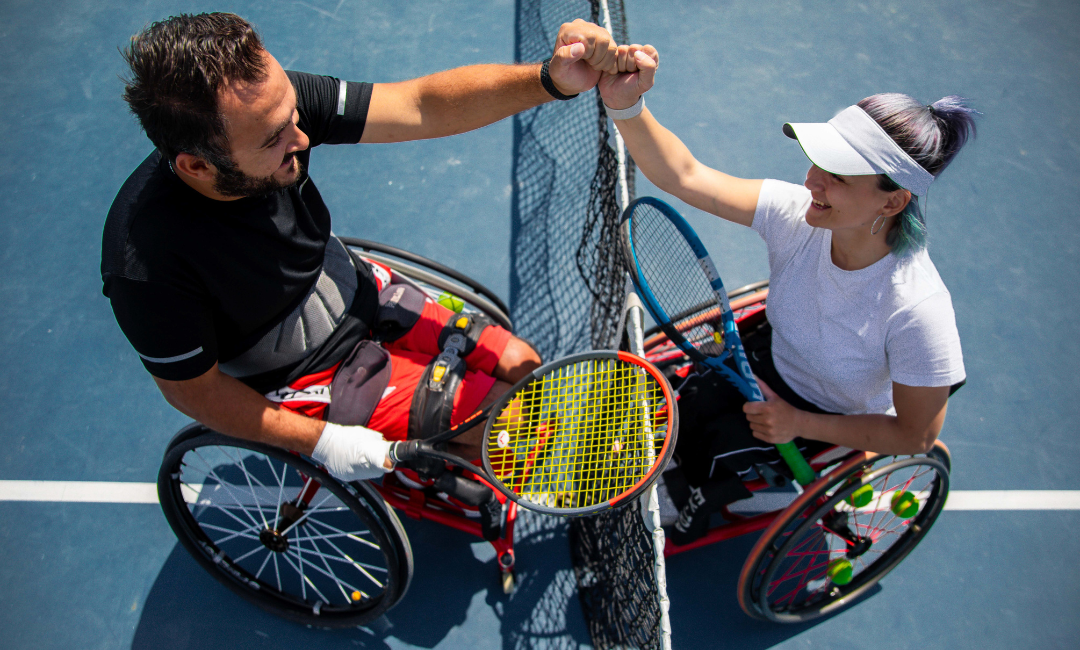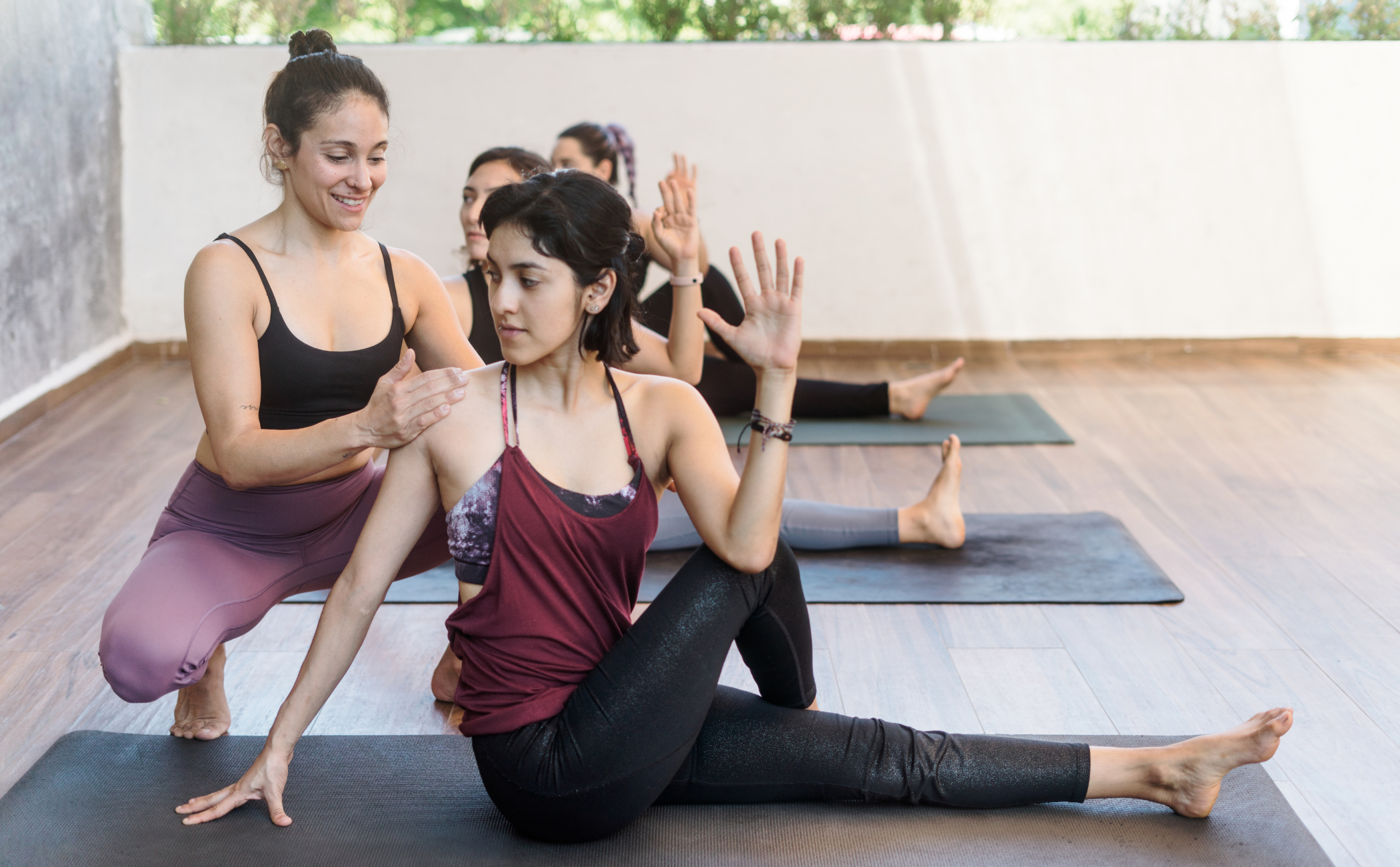In a world that is increasingly embracing diversity and inclusion, the domain of fitness and sports has made remarkable strides toward empowering individuals with disabilities. Adaptive Workouts for Disabilities is not only a cornerstone for physical health but also a vital contributor to mental well-being, confidence, and social connection. Tailoring fitness routines for people with disabilities ensures accessibility, safety, and engagement for all.
This blog delves into a full-week adaptive exercise routines for disabled individuals plan designed for individuals with diverse disabilities, spanning physical, sensory, and cognitive impairments. Whether you’re an athlete in adaptive sports or someone exploring the benefits of adaptive workouts for disabilities for the first time, this plan offers a roadmap to staying active, healthy, and motivated. You should know about the remarkable achievements of disabled individuals who have rewritten the narrative of human potential and resilience. History is brimming with awe-inspiring stories of triumph, such as the legendary Marla Runyan, a visually impaired athlete who became a three-time national champion in the women’s 5000 meters, proving that determination knows no bounds. Closer to home, Indian para-athletes have illuminated the global stage with their extraordinary feats. Deepa Malik, an unstoppable force of resilience despite being paralyzed below the waist, etched her name in history as the first Indian woman to secure a medal at the Paralympic Games, earning a silver in the shot put event at Rio 2016. Similarly, Devendra Jhajharia, who lost his left hand in a childhood accident, etched his name in history by winning two gold medals in javelin throw at the Paralympics, setting world records along the way.
Their stories serve as powerful reminders that physical limitations are no barriers to greatness when fueled by relentless spirit and purpose. These achievements underscore the profound impact of adaptive workouts for disabilities and nutrition, showcasing how the human body and mind can be empowered to surpass expectations, no matter the challenge.
Types of Disabilities and Their Unique Fitness Considerations :
Before diving into the weekly plan, it’s essential to understand the different categories of disabilities and the specific adaptations required for each:
Physical Disabilities :
Examples: Spinal cord injuries, cerebral palsy, amputations, muscular dystrophy.
Considerations: Focus on upper body strength, balance, and flexibility exercises, often incorporating adaptive equipment like resistance bands or wheelchairs.
Tips and Exercises :
Seated Strength Training: Use resistance bands for bicep curls, lateral raises, and rows.
Wheelchair Pushes: A cardio activity that builds endurance and arm strength.
Stretching Routine: Focus on shoulders, neck, and back to relieve tension.
Sensory Disabilities :
Examples: Visual impairments, hearing impairments.
Considerations: Clear communication, tactile or auditory cues, and spatial awareness exercises.
Tips and Exercises :
Guided Cardio: Partner-based walking or running for the visually impaired.
Tactile Yoga: Use verbal and touch cues to guide poses.
Sound-Based Sports: Activities like goalball or adaptive Zumba using auditory cues.
Cognitive Disabilities :
Examples: Down syndrome, autism spectrum disorder, intellectual disabilities.
Considerations: Simple instructions, structured routines, and activities that improve motor coordination.
Tips and Exercises :
Dance Routines: Simple, repetitive dance movements to encourage coordination and fun.
Sphere Activities: Gentle tossing and receiving to enhance coordination and fine motor abilities.
Visual Schedules: Use charts or videos to outline workout routines.
Chronic Conditions and Invisible Disabilities :
Examples: Chronic pain, multiple sclerosis, fibromyalgia.
Considerations: Gentle, low-impact exercises and pacing to prevent fatigue or exacerbation of symptoms.
Tips and Exercises :
Water Aerobics: Low-impact cardio that’s easy on joints.
Tai Chi: Gentle, flowing movements for balance and relaxation.
Breathing Exercises: Incorporate diaphragmatic breathing to reduce stress.
Adaptive Equipment and Tools :
To enhance the inclusivity of these exercises, consider the following adaptive equipment:
Resistance bands with handles for easy grip.
Stability balls for seated exercises.
Handcycles or upper-body ergometers for cardio.
Adaptive sports gear (e.g., specialized wheelchairs, tactile balls).
Mobile apps designed for accessibility and guided workouts.
Weekly Exercise Plan :
Day 1 : Mobility and Flexibility exercise
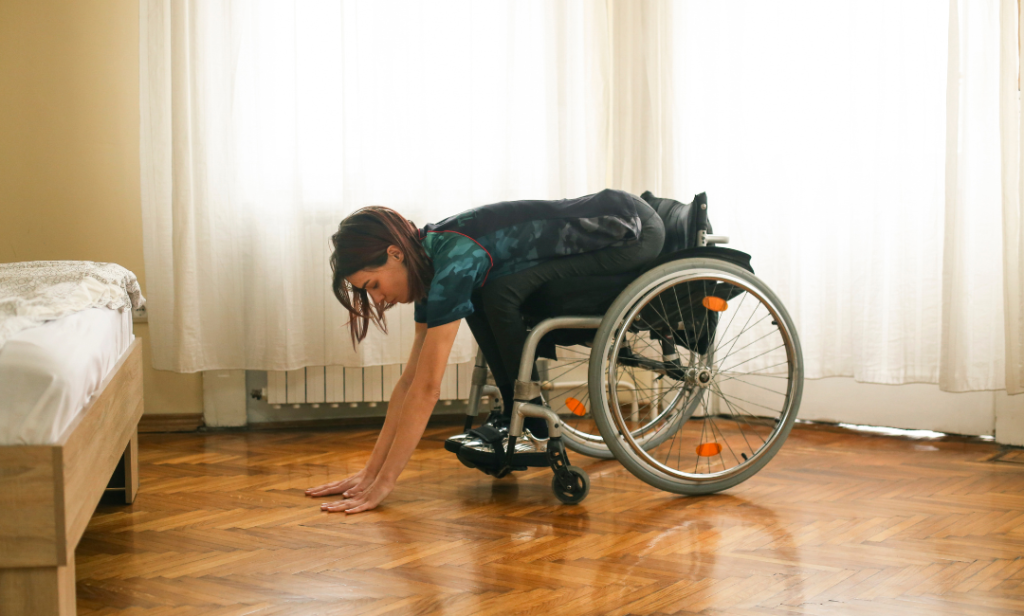
Mobility and flexibility exercises form the foundation for improved movement, reduced stiffness, and injury prevention. These adaptive exercise routines for disabled individuals are particularly beneficial for individuals with physical disabilities or chronic pain conditions.
Warm-Up:
Seated stretches (e.g., shoulder rolls, neck stretches) for wheelchair users.
Standing or seated dynamic stretches (e.g., arm circles, seated leg extensions).
Main Routine:
Chair Yoga: Adaptive poses like seated cat-cow, side bends, and forward folds.
Resistance Band Stretching: Targeting the shoulders, chest, and legs.
Gentle Pilates: Focus on core activation and alignment.
Cool-Down:
Deep breathing and mindfulness meditation.
Day 2 : Cardiovascular Fitness exercise
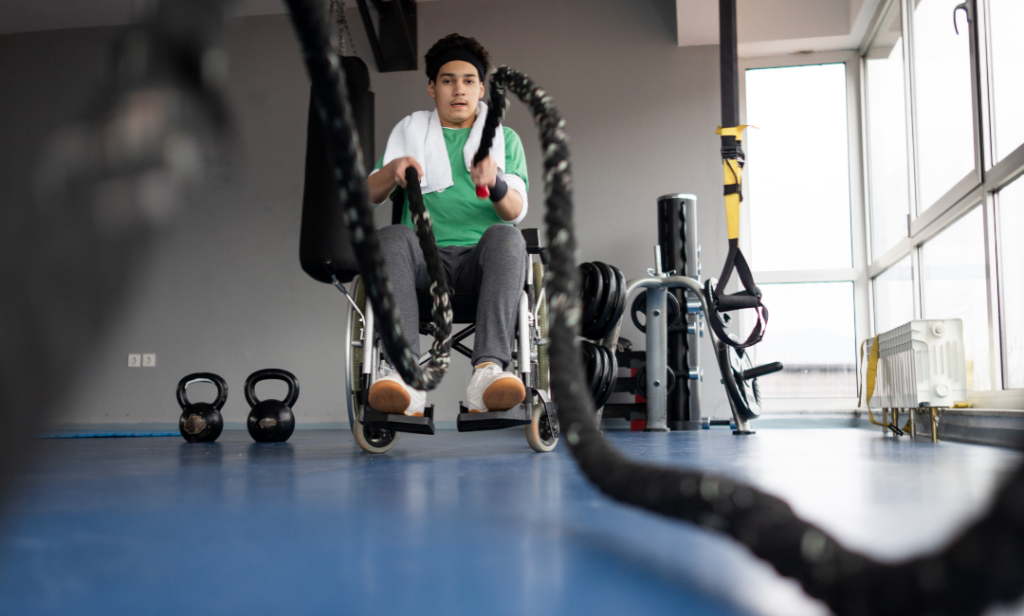
Cardio exercises boost heart health, endurance, and energy levels. Dynamic cardiovascular training can be executed with limited gear or simple adjustments.
Warm-Up:
Rhythmic seated movements (e.g., arm swings, torso twists).
Marching in place (seated or standing).
Main Routine:
Arm Cycling: Using a handcycle or upper-body ergometer for individuals with lower-body mobility challenges.
Adaptive Zumba: Dance-based fitness with modifications for wheelchair users or those with limited mobility.
Walking/Guided Running: For visually impaired individuals, guided walking or running with a tether partner.
Cool-Down:
Gentle stretching and slow-paced movements.
Day 3 : Strength Training exercise
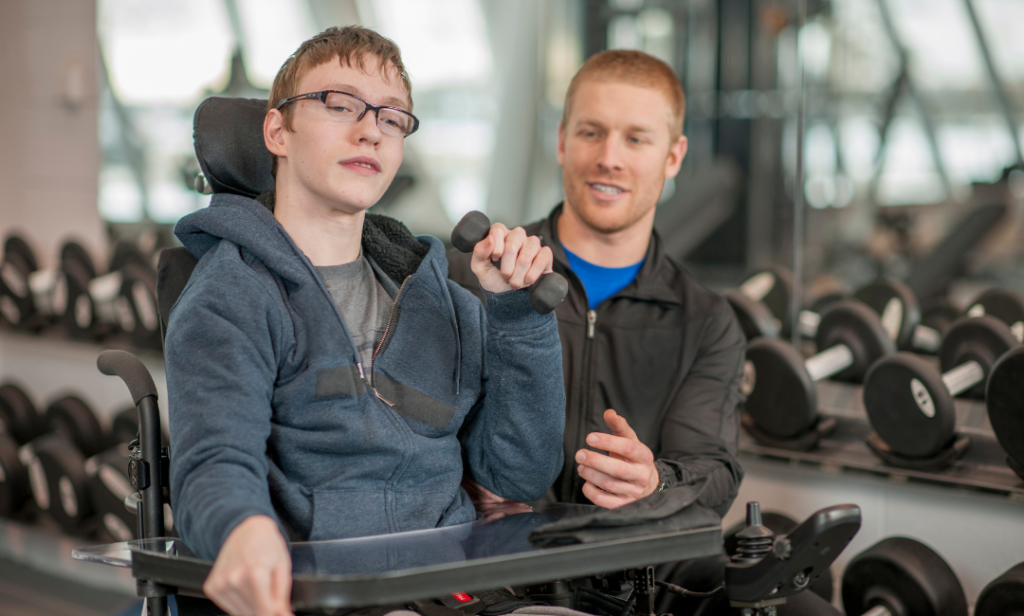
Strength training is vital for building muscle, improving posture, and enhancing daily functional movements. Adaptive strength training focuses on safe and effective resistance-based exercises.
Warm-Up:
Seated or standing light resistance band pulls.
Joint rotations (e.g., wrists, ankles, shoulders).
Main Routine:
Upper Body: Seated dumbbell presses, bicep curls, and resistance band rows.
Lower Body (if applicable): Wall sits, leg lifts, or resistance band kickbacks.
Core: Seated or lying torso twists, medicine ball passes.
Cool-Down:
Relaxation stretches focusing on worked muscle groups.
Day 4 : Balance and Coordination
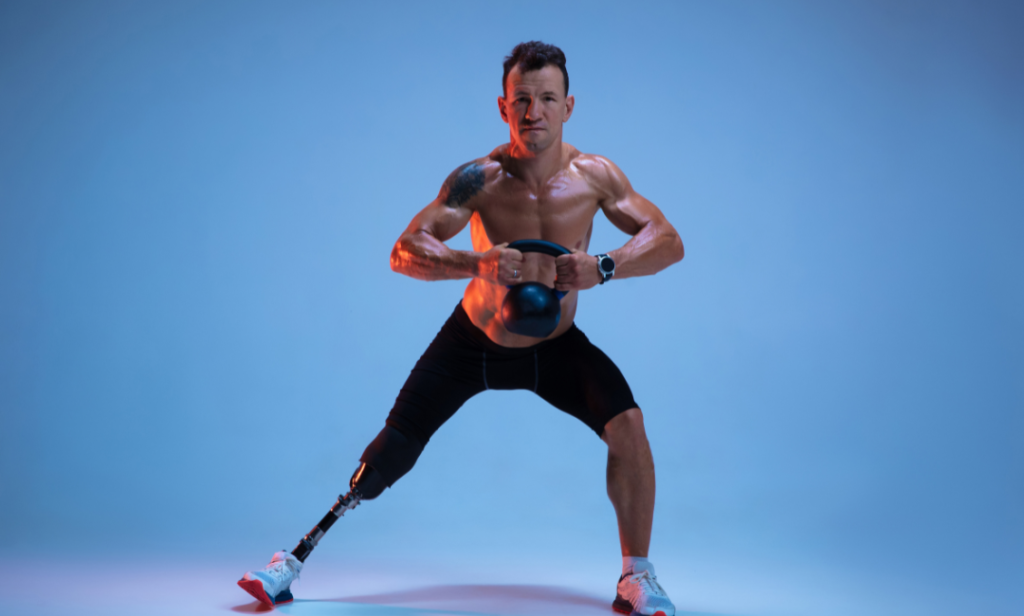
Balance and coordination exercises improve stability, prevent falls, and enhance motor skills. These are especially beneficial for individuals with neurological or physical impairments.
Warm-Up:
Gentle side-to-side weight shifts.
Arm and leg swings.
Main Routine:
Seated Balance: Using a stability ball or wobble cushion.
Obstacle Navigation: For visually impaired individuals, guided movement through tactile or verbal cues.
Tai Chi: Adaptive Tai Chi focusing on controlled, flowing movements.
Cool-Down:
Breathing exercises and light stretching.
Day 5 : Recreational Sports
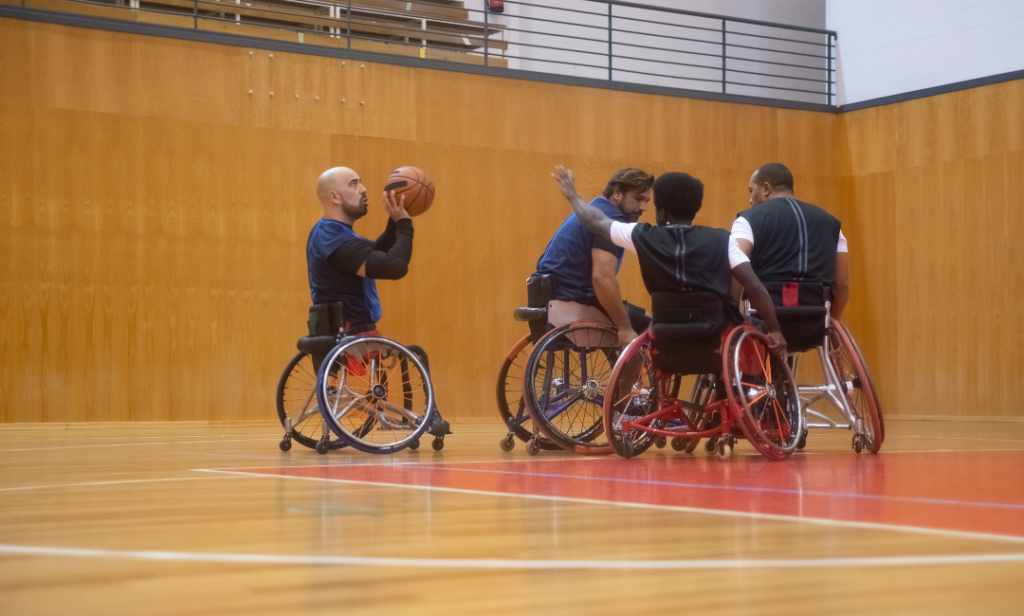
Integrating physical activities into daily life introduces an aspect of enjoyment, camaraderie, and rivalry. Adaptive sports foster inclusivity and provide an excellent workout.
Warm-Up:
Sport-specific movements (e.g., dribbling for wheelchair basketball).
Main Routine:
Para Basketball: Emphasizing dexterity, collaboration, and robust upper-body power.
Adaptive Swimming: Using flotation devices or modified strokes.
Goalball: A sport tailored for individuals with visual impairments.
Cool-Down:
Stretching and hydration.
Day 6 : Mind-Body Connection

Mind-body exercises like yoga and meditation improve mental clarity, reduce stress, and enhance overall well-being.
Warm-Up:
Gentle breathing exercises and seated stretches.
Main Routine:
Adaptive Yoga: Poses like child’s pose, warrior, and seated sun salutations.
Guided Meditation: Focusing on mindfulness, relaxation, and positive visualization.
Cool-Down:
Progressive muscle relaxation.
Day 7 : Active Recovery
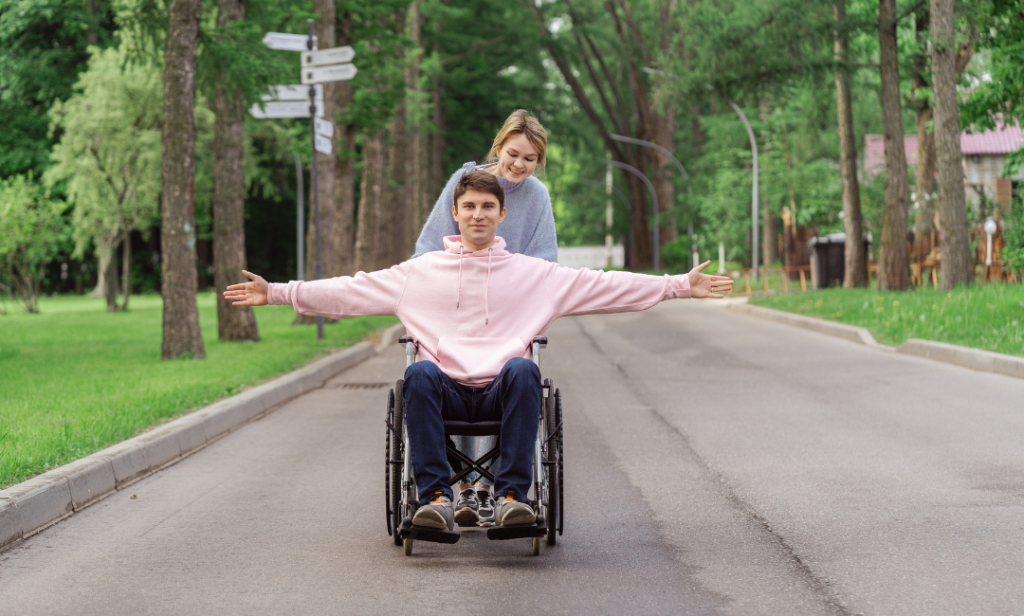
Recovery is as important as the workout itself. Active recovery involves light movements to promote blood flow and muscle repair.
Routine:
Leisurely walks or wheelchair rolls.
Gentle stretches or foam rolling.
Hydration and reflection on weekly progress.
Final Thoughts :
Fitness is for everyone, regardless of ability. By embracing tailored adaptive workouts for disabilities routines and adaptive sports, disabled individuals can experience the transformative benefits of physical activity. This weekly plan serves as a stepping stone toward a healthier, more active lifestyle—a testament to the boundless potential of the human spirit.
Adaptive workouts for disabilities remember, the key to success lies in consistency, patience, and celebrating every achievement, big or small. The journey to fitness is not a race but a fulfilling, lifelong adventure. And there are many more victories to embrace along the way. Every step forward, no matter how small, is a triumph of determination and resilience. By nurturing the body, mind, and spirit through movement, disabled individuals unlock a wellspring of confidence, strength, and self-discovery. Let this journey be a reminder that true empowerment lies not in limitations but in the courage to rise above them. The road ahead is filled with opportunities to redefine boundaries, inspire others, and celebrate the extraordinary power of perseverance. So, take that first step—and let it echo as a declaration of your limitless potential.
How can I exercise if I'm disabled?
Engage in pursuits that elevate your heart rate — such as brisk strolling, seated shadowboxing, aquatic exercise, or leaf gathering. Strive, if possible, for 150 minutes weekly of aerobic activity at a moderate level of intensity.
What is the best exercise if you can not walk?
You can do seated aerobic exercises, involving rhythmic and continuous motions, can elevate your heart rate and promote calorie burning. Similarly, strength training routines executed at an accelerated tempo with numerous repetitions provide comparable benefits. In essence, any swift, repetitive actions contribute to cardiovascular health while also aiding in alleviating joint stiffness.
Football, often called “the beautiful game,” is more than just a sport—it’s a global phenomenon that transcends boundaries and unites people from diverse backgrounds. Whether you’re a student seeking discipline, an aspiring professional, or someone simply looking for a healthier lifestyle, football offers countless opportunities to transform your life. In this blog, we explore how you can embrace football, improve your skills, and unlock its many benefits, both on and off the field.
What things make the disabled person stronger?
A person with a disability who consistently embraces benevolence often possesses remarkable mental fortitude compared to others. This strength stems from their profound grasp of understanding, sensitivity, and altruism, even amidst overwhelming adversity.


